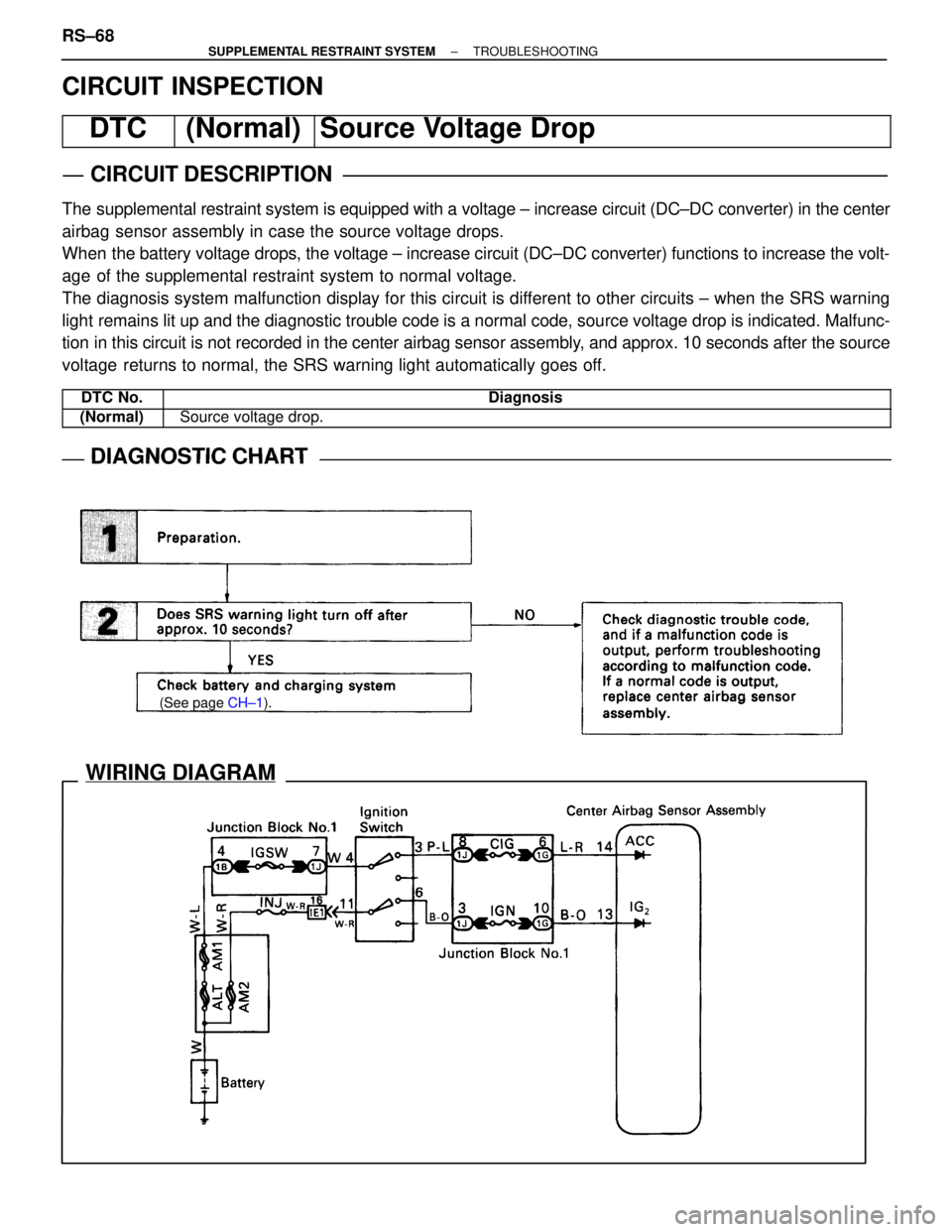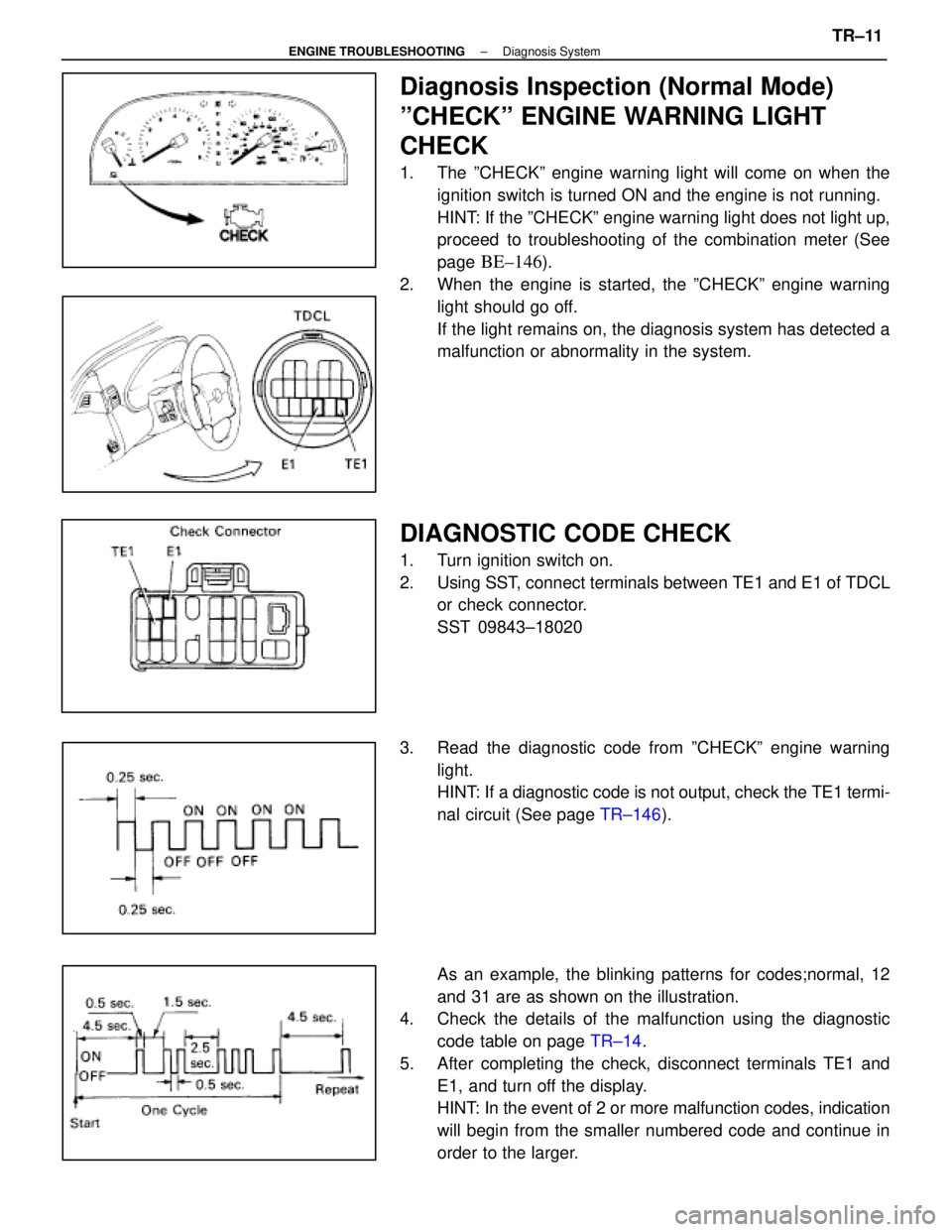Page 3172 of 4087

WIRING DIAGRAM
CIRCUIT INSPECTION
DTC(Normal)Source Voltage Drop
CIRCUIT DESCRIPTION
The supplemental restraint system is equipped with a voltage ± increase \
circuit (DC±DC converter) in the center
airbag sensor assembly in case the source voltage drops.
When the battery voltage drops, the voltage ± increase circuit (DC±DC\
converter) functions to increase the volt-
age of the supplemental restraint system to normal voltage.
The diagnosis system malfunction display for this circuit is different to other circuits ± when the SRS warning
light remains lit up and the diagnostic trouble code is a normal code, source\
voltage drop is indicated. Malfunc-
tion in this circuit is not recorded in the center airbag sensor assembly, and approx. 10 seconds after the source
voltage returns to normal, the SRS warning light automatically goes off.
DTC No.Diagnosis
(Normal)Source voltage drop.
DIAGNOSTIC CHARTDIAGNOSTIC CHART
(See page CH±1).
RS±68±
SUPPLEMENTAL RESTRAINT SYSTEM TROUBLESHOOTING
WhereEverybodyKnowsYourName
Page 3201 of 4087

DTC15Open in Front Airbag Sensor Circuit
CIRCUIT DESCRIPTION
The front airbag sensor detects the deceleration force in a frontal collisi\
on and is located in the front fender on
the left and right sides.
For details of the function of each component, see FUNCTION OF COMPONENTS o\
n page RS±10. Diagnostic
trouble code 15 is recorded when an open is detected in the front airbag sensor\
circuit.
NOTICE: The front airbag sensor connector is equipped with an electrical connec\
tion check mechanism
for the purpose of detecting an open in the front airbag sensor (See pa\
ge RS±13). This mechanism is
constructed so that when the terminals of the front airbag sensor have been connect\
ed (when the con-
nector housing lock is in the locked condition), the connection detection pin\
on the wire harness side
connects with the terminals for diagnosis use on the sensor side. If the connector is \
not properly con-
nected, the diagnosis system may detect only a malfunction code, even though the supplemental re-
straint system is functioning normally. When connecting the front airbag sensor connector, make sure
it is connected properly. If diagnostic trouble code 15 is displayed after the front airbag sens\
or connec-
tor has been connected, check again that it is properly connected.
DTC No.Diagnosis
15
� Open circuit in +S wire harness or ±S wire harness of front airbag se\
nsor.
� Front airbag sensor malfunction.
� Malfunction of electrical connection check mechanism of front airbag sen\
sor.
� Center airbag sensor assembly malfunction.
±
SUPPLEMENTAL RESTRAINT SYSTEM TROUBLESHOOTINGRS±97
WhereEverybodyKnowsYourName
Page 3206 of 4087

DTC22SRS Warning Light System Malfunction
CIRCUIT DESCRIPTION
The SRS warning light is located on the combination meter.
When the supplemental restraint system is normal, the SRS warning light ligh\
ts up for approx. 6 seconds after
the ignition switch is turned from LOCK position to ACC or ON position, and then turn\
s off automatically. If there
is a malfunction in the supplemental restraint system, the SRS warning l\
ight lights up to inform the driver of the
abnormality.
When terminals Tc and E
1 of the DLC2 are connected, the diagnostic trouble code is displayed by the blinking
of the SRS warning light.
The SRS warning light circuit is equipped with an electrical connection che\
ck mechanism which detects when
the connector to the center airbag sensor assembly is not properly connecte\
d.
If the connector to the center airbag sensor assembly is not properly conn\
ected, the SRS warning light will not
light up.
Diagnostic trouble code 22 is recorded when a malfunction occurs in the SRS warnin\
g light system. If an OPEN
malfunction occurs in the SRS warning light system, the SRS warning light does not light up, so that until the
malfunction is repaired, the diagnostic trouble codes (including 22) c\
annot be confirmed.
DTC No.Trouble Area
22� Open circuit in SRS warning light system.
� Center airbag sensor assembly malfunction.
RS±102±
SUPPLEMENTAL RESTRAINT SYSTEM TROUBLESHOOTING
WhereEverybodyKnowsYourName
Page 3212 of 4087
DTC31Center Airbag Sensor Assembly Malfunction
CIRCUIT DESCRIPTION
The center airbag sensor assembly consists of center airbag sensor, safing sensors, ignition control and drive
circuit, diagnosis circuit, etc.
It receives signals from the airbag sensors, judges whether or not the SRS must be deploy, and diagnoses sys-
tem malfunction.
Diagnostic trouble code 31 is recorded when occurrence of a malfunction in the cen\
ter airbag assembly is de-
tected.
DTC No.Trouble Area
31�Center airbag sensor assembly malfunction.
DIAGNOSTIC CHARTDIAGNOSTIC CHART
HINT: When a malfunction code other than code 31 is displayed at the same time, first repair the malfunction
indicated by the malfunction code other than code 31.
(See page RS±65).
RS±108±
SUPPLEMENTAL RESTRAINT SYSTEM TROUBLESHOOTING
WhereEverybodyKnowsYourName
Page 3213 of 4087
YESNO
INSPECTION PROCEDURE
HINT: When a malfunction code other than code 31 is displayed at the same time, first repair the malfunction
indicated by the malfunction code other than 31.
1Is diagnostic rouble code 31 output again?
C
PClear malfunction.
1. Turn ignition switch LOCK, and wait at least 20 sec-onds.
2. Turn ignition switch ACC or ON, and wait at least 20 seconds.
3. Repeat operation in step (1) and (2) at least 5 times.
4. Using SST, connect terminals Tc and E
1 of DLC2.
SST 09843±18020
5. Check diagnostic trouble code.
Using simulation method, reproduce malfunction symp-
toms (See page RS±65).
Replace center airbag sensor assembly.
±
SUPPLEMENTAL RESTRAINT SYSTEM TROUBLESHOOTINGRS±109
WhereEverybodyKnowsYourName
Page 3375 of 4087

HOW TO PROCEED WITH TROUBLESHOOTING
The Engine Control System broadly consists of the sensors, ECU and actuator\
s. The ECU receives signals from
various sensors, judges the operating conditions and determines the opti\
mum injection duration, timing, ignition
timing and idle speed.
In general, the Engine Control System is considered to be a very intricate\
system to troubleshoot. But, the fact
is that if you proceed to inspect the circuit one by one following the p\
rocedures directed in this manual, trouble-
shooting of this system is not complex.
This section explains the most ideal method of troubleshooting and tells how\
to carry out the necessary repairs.
[1] CUSTOMER PROBLEM ANALYSISUsing the customer problem analysis check sheet for reference, ask the c\
ustomer in as much details as
possible about the problem.
[2] CHECK AND CLEAR DIAGNOSTIC CODE (PRECHECK) Before confirming the problem symptom, first check the diagnostic code and mak\
e a note of any malfunc-
tion code which is output, then clear the code.
HINT: Output of the malfunction code indicates that there is a malfunction in\
the circuit indicated. However,
it does not indicate whether the malfunction is still occurring or occur\
red in the past and returned to normal.
In order to determine this, the problem symptoms should be confirmed in 4 \
first and the diagnostic code
be rechecked in [6].
Accordingly, if troubleshooting is begun based on the malfunction code only in diag\
nostic code check in
[2] , it could result in a misdiagnosis, leading to troubleshooting of circuits which are normal \
and making
it more difficult to locate the cause of the problem.
[3] SETTING THE TEST MODE DIAGNOSIS, [4] PROBLEM SYMPTOM CONFIRMATION, [5] SYMPTOM SIMULATION
In order to find out the trouble more quickly, set the diagnosis check in test mode and with higher sensing
ability of the ECU, confirm the problem symptoms. If the trouble does not reappear, use the symptom simu-
lation method to make sure the trouble is reproduced.
[6] DIAGNOSTIC CODE CHECK IN TEST MODE Check the diagnostic code in test mode. If the malfunction code is output, pr\
oceed to ºstep [8] Diagnostic
Code Chartº. If the normal code is output, proceed to ºstep [7] Basic Inspectionº.
[7] BASIC INSPECTION Carry out basic inspection such as the spark check and fuel pressure che\
ck, etc.
[8] DIAGNOSTIC CODE CHART If the malfunction code is displayed, proceed to inspect the circuit ind\
icated by the chart for each code.
[9] MATRIX CHART OF PROBLEM SYMPTOMS If the normal code is displayed in the diagnosis in test mode, perform tro\
ubleshooting according to the in-
spection order in the Matrix Chart of Problem Symptoms.
[10] PARTS INSPECTION When the Matrix Chart of Problem Symptoms instructs to check the parts, proc\
eed to parts inspection sec-
tion included in this manual.
[11] CIRCUIT INSPECTION Determine if the malfunction is the sensor, actuator, wire harness, connector or the ECU.
TR±2
±
ENGINE TROUBLESHOOTING How to Proceed with Troubleshooting
WhereEverybodyKnowsYourName
Page 3379 of 4087
![LEXUS SC300 1991 Service Repair Manual
How to Proceed with Troubleshooting Using Volt/Ohm Meter
and TCCS Checker
For the explanation of steps [1] ~ [6], [8] and [10] ~ [16], see the explan\
ation of steps with the same title on page
TR±2 LEXUS SC300 1991 Service Repair Manual
How to Proceed with Troubleshooting Using Volt/Ohm Meter
and TCCS Checker
For the explanation of steps [1] ~ [6], [8] and [10] ~ [16], see the explan\
ation of steps with the same title on page
TR±2](/manual-img/36/57052/w960_57052-3378.png)
How to Proceed with Troubleshooting Using Volt/Ohm Meter
and TCCS Checker
For the explanation of steps [1] ~ [6], [8] and [10] ~ [16], see the explan\
ation of steps with the same title on page
TR±2.
[7] [9] CIRCUIT INSPECTION BY CHECKER If the Normal code is displayed in the diagnostic code check, connect the \
checker to the vehicle and check
all the circuits which can be inspected using the checker.
If a malfunctioning circuit is then detected, proceed to ºCircuit Ins\
pection by Volt/Ohm Meterº and check
the applicable circuit using a volt/ohm meter. Determine if the malfunction is in the sensor, actuator, wire
harness, connector or the ECU. If the malfunctioning circuit cannot be detected u\
sing the checker, proceed
to ºBasic Inspectionº and perform troubleshooting.
If a malfunction code is displayed in the diagnostic code check, use the c\
hecker to inspect the circuit indi-
cated by the diagnostic code chart for the displayed code.
For instructions on how to connect the checker to the vehicle and how to us\
e the checker, please refer to
the Instruction Manual for TCCS checker.
TR±6
±
ENGINE TROUBLESHOOTING How to Proceed with Troubleshooting
WhereEverybodyKnowsYourName
Page 3384 of 4087

Diagnosis Inspection (Normal Mode)
ºCHECKº ENGINE WARNING LIGHT
CHECK
1. The ºCHECKº engine warning light will come on when theignition switch is turned ON and the engine is not running.
HINT: If the ºCHECKº engine warning light does not light up,
proceed to troubleshooting of the combination meter (See
page
BE±146).
2. When the engine is started, the ºCHECKº engine warning light should go off.
If the light remains on, the diagnosis system has detected a
malfunction or abnormality in the system.
DIAGNOSTIC CODE CHECK
1. Turn ignition switch on.
2. Using SST, connect terminals between TE1 and E1 of TDCLor check connector.
SST 09843±18020
3. Read the diagnostic code from ºCHECKº engine warning light.
HINT: If a diagnostic code is not output, check the TE1 termi-
nal circuit (See page TR±146).
As an example, the blinking patterns for codes;normal, 12
and 31 are as shown on the illustration.
4. Check the details of the malfunction using the diagnostic
code table on page TR±14.
5. After completing the check, disconnect terminals TE1 and E1, and turn off the display.
HINT: In the event of 2 or more malfunction codes, indication
will begin from the smaller numbered code and continue in
order to the larger.
±
ENGINE TROUBLESHOOTING Diagnosis SystemTR±11
WhereEverybodyKnowsYourName